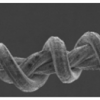Device for coating wires with biodegradable polymers
Technology description
| The name of the technology: | Device for coating wires with biodegradable polymers |
|---|---|
| Challenge: |
Biodegradable polymers and especially biodegradable metal wires are becoming increasingly popular in current implant and routine surgery. The combination of metal parts coated with polymers, especially thin wires (with ø in the order of hundreds of µm), with demands on flexibility is challenging to manufacture. Production is often manual and does not allow control of the parameters of the often unevenly folded polymer layer. The metal part degrades rapidly and its mechanical properties deteriorate. At the same time, there is a lack of reliable equipment on the market capable of industrial production of polymer-coated wires while ensuring consistent quality and homogeneity of the layer without the usual technical problems such as bubble formation, production at a certain speed or unstable thickness in the cross-section. |
| Description: |
We have developed and are currently testing equipment for coating biodegradable, thin wires to enable industrial production and to guarantee stability of technical parameters such as controlled polymer deposition rate, controlled delay of wire biodegradation and required homogeneous layer thickness. These wires are in lengths of metres and diameters of hundreds of µm. They are used for example in implant surgery and other sectors. At the moment, in vitro and in vivo tests on minipigs are being performed to evaluate implantation. Magnesium wires have proven to be suitable, as the widely used biodegradable alloys of Mg and Ca cannot be effectively used for the production of thin wires. The selected polymers generally have very good mechanical properties compared to other polymers used and are promising for use in a wide range of bioapplications (stents, surgical sutures, bone screws and plates, vascular fixation, etc.). Mg wires were developed and supplied by the Institute of Physics of the CAS. The design of the device allows, thanks to a special procedure of coating the wires with polymer solution, to control both the variability of the length of the wire wound on the coil (up to several meters) and the coating parameters ensuring the same layer thickness. The device will also make it possible to slow down the initial stages of biodegradation in a controlled manner and even design the dissolution rate of the implants taking into account the type of implants and the physiological parameters of the patient (age, weight, etc.). With the appropriate choice of polymer, both thin biodegradable wires and materials that degrade too rapidly for some applications without coating (Mg, Zn) can be used. The equipment will enable commercial industrial production of large volumes. |
| Commercial opportunity: |
- Implant Surgery - Veterinary Surgery - Tissue Engineering |
| IP protection status: | |
| Development status: |
Phase 2Corresponds with TRL 3 and TRL 4 Feasibility study. There is a realistic design of the technology and the initial tests in the laboratory are leading to the specification of the technology requirements and its capabilities.
|
| Partnering strategy: | Co-development |
| More information: | We are looking for industrial partners to collaborate in downstream development and testing for both medical and other applications using thin biodegradable metal wires. |
| Images: | |
| Categories: | Life Science and Health Chemical and bioengineering |
| Owner of a technology: |

